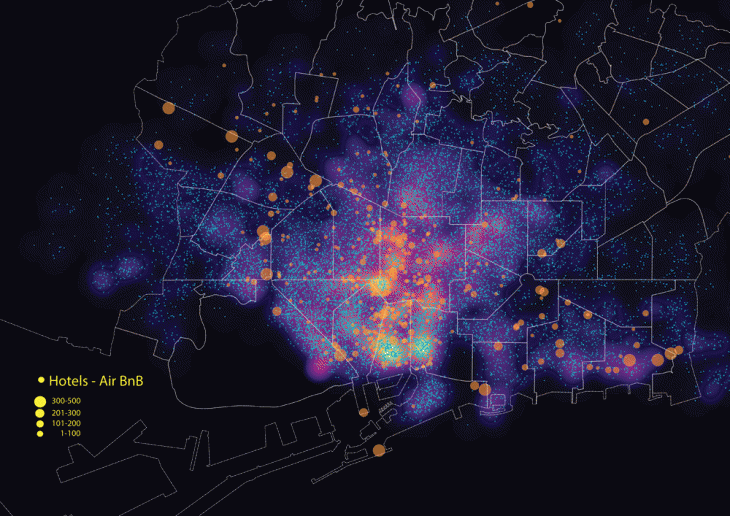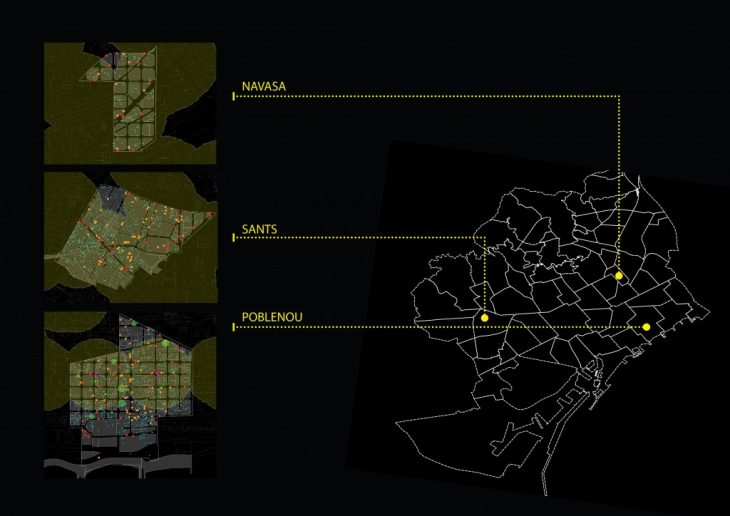Sprawl for Tourist
(Urban Shared Load Capacity)
Urban Analytics
Master’s in City and Technology 2016-17
Institute for Advanced Architecture of Catalonia
Barcelona, Spain
Tutors: Luis Falcon
Students: Abhignya Grandhi, Peng Wang & Pratyaksh Sharma

This seminar gave us an incite of tourism and its growing needs and problems faced within a city and how tourism economic model can affect city and it’s management cycle. We start with the exponential growth of Barcelona’s Tourism especially after the Barcelona Olympic Games as we see Barcelona today. Being one of the most popular stops on the Globe to travel resulting in higher population density of Barcelona.

Hence keeping its current and fast growth we decided to look at city’s mobility aspects as it’s ranked 68th in the world and 18th in Europe most traffic zoned areas with an annual growth of 3% along side being in the top 10 European Cities with 8.5% increment in number of beds annually. In order to understand this we tried to map the ratio of number of beds in the Vacatinal Rental Housing systems and Hotel Systems and related industry along side the travel module of the city respectively.






By understanding the attractions of the city and its Mobility Module we decided to come up with a buffer zone system around the mobility modes in the city. Understanding it’s effects, purpose and betterment for the city.



First of all by creating these buffer zones we wanted to reduce the taxes people nearer to the mobility modules as they are as it is being busy zones could create some kind of diversion between the between residential spaces and tourist housings.
Secondly, by creating a per neighborhood voting pallet to limit the number of houses in each of the neighborhood and create an equal balance of Tourist not just concentrated in particular zones of the city but spread through out the city.

With the central voting system authorities will have the full data sets at their end also giving the chance of public options of improvement in the vacational housing rentals. With the App and Portal citizens can be updated with the status of their own rentals and around the neighborhood. Where they can keep and updated status regarding their license as well.


With this we not only create an opportunity for the citizens but a proper regulation in the system controlled and upgraded by authorities. The voting system by the citizens will belong to each of the 73 respective neighborhoods in order to generate more awareness and responsibilities towards their own neighborhood.
On the other hand the tourist will be rating the host and the house as a part of their experience living there. Hence, creating more opportunities for the host to improve upon the standards of their living and rentals as expected throughout the vacational rental market by maintaining their own homes and neighborhoods. And the citizens are creating an equal distribution of houses in each of the Barrio.


By the use of this portal of voting the authorities will have the full control over the licensing of the vacational rental houses. The vacational rental platforms will act as a common platform between the users and the authorities with the liquid license system for rental from the authorities and the hosts. We suggested that the authorities will grant an annual license to the Vacational Rental Platforms with the power of granting a 6 month term (approx) licenses to the hosts which they can easily renew if with good feed back and ratings for the next terms. Easily manageable through the portal itself.
And the entire data base of the legalized activities to be handled by the authorities keep them in-charge of each and every situation if any illegal happenings happen.
With this we not only create a connected transparent community and city but also the filled bridge between the authorities, citizens, vacational rentals and tourist of the city making it safer, organised and better. With this the city’s growth in terms of tourist and its management would increase as well as creating growth for Citizens, Vacational Rentals and the Authorities.



Hence with this we can keep a track on the Urban Shared Load Capacity of each district and a proper maintenance of each neighborhood around the city. Determining the density of citizens, density of loving facilities and density of transportation facilities. Through which we can keep an equal distribution of the tourism throughout the city with enhancement and growth of the city.
________________________________________________________________________________
Sprawl for Tourist – Urban Shared Load Capacity (Abhignya, Peng, Pratyaksh)
________________________________________________________________________________
